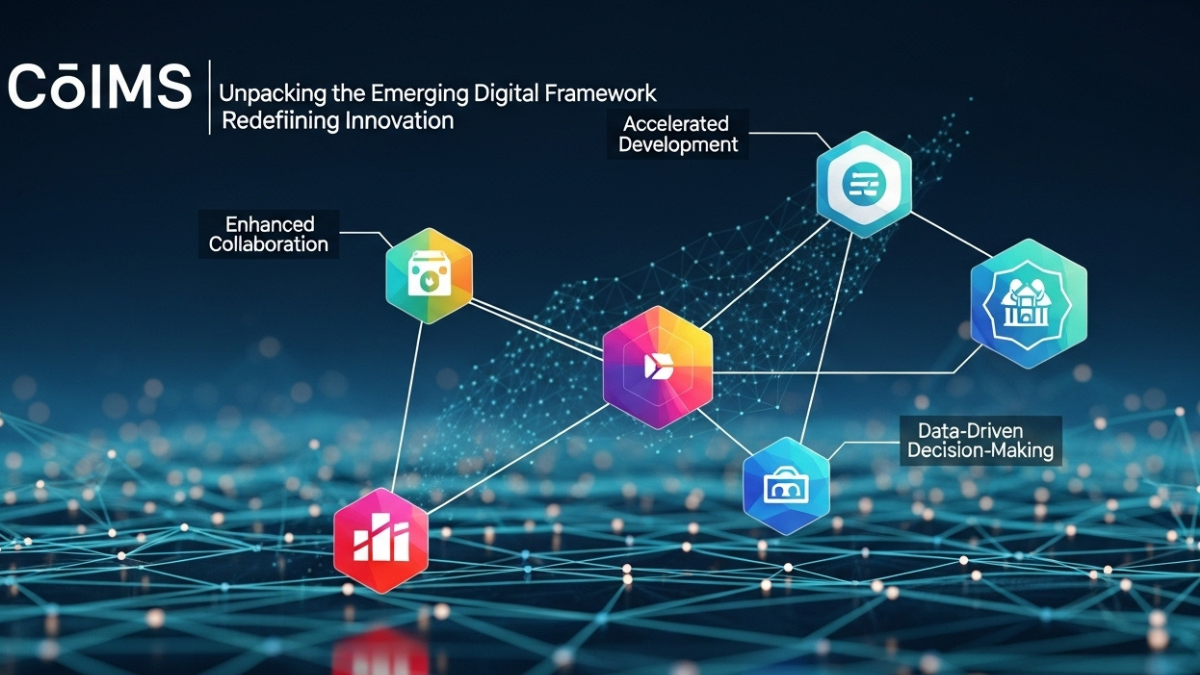technology
CÑIMS: Unpacking the Emerging Digital Framework Redefining Innovation

In the age of digital transformation, cryptic acronyms and coined terminologies often represent groundbreaking systems, frameworks, or philosophies that reshape how industries operate. One such term making quiet but significant waves in online searches and tech-savvy communities is “CÑIMS.” Mysterious at first glance, CÑIMS appears to represent an evolving paradigm in how data, information, management, and systems thinking come together in one coherent structure.
What is CÑIMS? Breaking Down the Term
The Structure of the Word
C – Could stand for Central, Cloud, Cyber, or Cognitive
Ñ – A unique letter (Spanish origin) suggesting regional, linguistic, or cultural specificity
I – Information, Intelligence, or Infrastructure
M – Management, Model, or Mechanism
S – System, Solution, or Simulation
Thus, one interpretation could be:
Cognitive Ñetworked Information Management System
Alternatively, it could represent a localized or culturally specific system architecture, integrating regional linguistic identity with modern data infrastructure.
Why CÑIMS Matters in the Digital Age
In a world driven by data, every digital interaction, business model, or public policy relies on how well information is collected, managed, and interpreted.
CÑIMS, as a conceptual model, is important for the following reasons:
Integrated Intelligence: Combines various layers of information—raw data, machine learning outputs, real-time analytics—into one accessible platform.
Cultural Contextualization: The “Ñ” may suggest adaptation for non-English languages, allowing localized systems to thrive.
Modular Scalability: CÑIMS could be flexible and scalable for multiple industries: from enterprise solutions to public infrastructure.
Core Components of a Hypothetical CÑIMS Architecture
To visualize how CÑIMS functions, imagine a system with the following pillars:
a. Data Collection Layer
IoT sensors
Web APIs
Legacy database connectors
User input systems
b. Networked Intelligence Layer
Real-time analytics
Predictive modeling
Machine learning integration
c. Cultural and Linguistic Interface
Support for regional dialects and language syntax (thanks to the inclusion of “Ñ”)
UI/UX design based on local customs and user behavior
d. Management Console
Dashboard with customizable KPIs
Alerts and automation
Integration with ERP or CRM tools
e. Output and Insights
Reports, data visualization, forecasting
Actionable intelligence in localized formats
Applications of CÑIMS Across Sectors
A. Smart Cities
CÑIMS could power:
Environmental monitoring with IoT feedback
Emergency response dashboards localized for regional authorities
B. Healthcare Systems
Patient data integration across hospitals and clinics
Multilingual medical records processing
AI-assisted diagnosis with culturally contextual guidance
C. Education
Adaptive learning platforms tailored to regional languages
School performance monitoring at district and national levels
Digitized curriculum analytics for policy making
D. Business Intelligence
SME dashboards combining finance, HR, sales, and marketing metrics
Regional market behavior analysis
Real-time decision-support systems
Advantages of Adopting a CÑIMS Framework
Localization and Inclusion
CÑIMS enables systems to adapt to non-English-speaking populations. It acknowledges that AI and data-driven systems must also be culturally aware.
Real-Time Responsiveness
Instead of waiting for weekly reports or batch processing, CÑIMS gives users up-to-the-second intelligence.
Plug-and-Play Architecture
Its modularity allows organizations to adopt CÑIMS components selectively—whether it’s just the analytics engine or the data visualization layer.
Enhanced Data Security
Thanks to regional adaptation, CÑIMS can respect data sovereignty laws by hosting or routing data within national boundaries.
Challenges to Implementing CÑIMS
A. Standardization
There needs to be uniform data standards across different sectors for CÑIMS to work seamlessly.
B. Cost and Complexity
For developing regions, deploying an advanced system like CÑIMS may require heavy initial investment and training of IT professionals.
C. Language Support
While “Ñ” symbolizes linguistic inclusion, natural language processing models for underrepresented languages remain underdeveloped.
How CÑIMS Could Integrate with Emerging Technologies
AI and Machine Learning
CÑIMS can be augmented with:
Self-learning algorithms that adjust based on user behavior
Anomaly detection in industrial or healthcare settings
Blockchain Integration
CÑIMS could utilize blockchain for:
Data validation
Tamper-proof auditing
Cross-border information flow
Edge Computing
Instead of routing everything to a central server, CÑIMS nodes could process data locally to reduce latency—ideal for smart agriculture, remote diagnostics, or disaster management.
CÑIMS and Digital Sovereignty
In countries pushing for digital sovereignty, a localized system like CÑIMS ensures:
National control over data policies
Multilingual support for public interfaces
AI infrastructure aligned with cultural values
This makes CÑIMS not just a tool for efficiency, but also a strategic asset in a digital-first world.
The Future of CÑIMS: What Comes Next?
Open Source Ecosystems
We may see a CÑIMS Foundation, where developers contribute to an open library of tools, languages, and UI components tailored to global regions.
Government Adoption
Just as many nations have adopted open-source ERP systems, governments may deploy CÑIMS for public data dashboards, especially in education, environment, and civic engagement.
AI-as-a-Service (AaaS)
CÑIMS could serve as a host platform for AI modules, allowing users to drag-and-drop services like forecasting, automation, or pattern recognition.
Multi-Cloud Deployments
To handle increasing data traffic, CÑIMS will likely support hybrid cloud environments, combining private, public, and edge computing strategies.
Final Thoughts: Why CÑIMS Is a Concept to Watch
CÑIMS isn’t just a strange acronym—it’s a metaphor and blueprint for the future of regionalized, intelligent, and modular systems. As the world becomes increasingly interconnected yet culturally diverse, we need frameworks that reflect both global standards and local nuance.
Whether it manifests as a public-sector tool, an enterprise management system, or a new AI operating layer, CÑIMS represents a shift toward more inclusive and adaptable digital infrastructure.
technology
From Installation to Impact: Understanding HMS Photovoltaik Systems

As the world shifts towards sustainable energy solutions, HMS Photovoltaik systems are emerging as a powerful player in the renewable energy landscape. These innovative solar technologies harness sunlight to generate clean electricity, making them a popular choice for both residential and commercial applications. But what exactly goes into these systems? How do they work, and what makes them stand out among other energy alternatives?
Whether you’re an eco-conscious homeowner or a business owner looking to cut costs while reducing your carbon footprint, understanding HMS Photovoltaik could be your key to a more sustainable future. Join us on this journey as we explore everything from installation processes to the broader impact of these impressive photovoltaic systems on our environment and economy.
How Do HMS Photovoltaik Systems Work?
HMS Photovoltaik systems harness sunlight to produce electricity, transforming how we power our lives. They utilize solar panels composed of photovoltaic cells that capture sunlight and convert it into direct current (DC) electricity.
The process begins when sunlight strikes the surface of these cells. This interaction excites electrons, causing them to move and generate an electric flow. The DC electricity is then channeled through an inverter, converting it to alternating current (AC), which is compatible with home appliances.
These systems can be grid-tied or stand-alone, depending on energy needs. A grid-tied system connects directly to the local utility, allowing excess power generation to feed back into the grid. In contrast, a stand-alone setup operates independently, ideal for remote locations without access to traditional power sources.
Monitoring devices track performance and energy output in real-time. This ensures optimal efficiency and helps users maximize their investment in renewable energy technology.
Types of HMS Photovoltaik Systems
HMS Photovoltaik systems come in several distinct types, each tailored to specific needs. The most common are grid-tied systems. These connect directly to the local utility grid, allowing users to draw power when needed and send excess energy back for credits.
Off-grid systems operate independently of the grid. They include battery storage options, making them ideal for remote locations where electricity access is limited or unreliable.
Hybrid systems combine both approaches. They provide flexibility by connecting to the grid while also utilizing batteries for backup. This setup ensures a steady power supply during outages.
Building-integrated photovoltaics (BIPV) seamlessly integrate solar technology into conventional structures like roofs or facades. This innovative design doesn’t just generate energy; it enhances aesthetic appeal too. Each type caters to different preferences and requirements in harnessing solar energy efficiently.
Benefits of Using HMS Photovoltaik Systems
HMS Photovoltaik systems offer numerous advantages for both residential and commercial users. One of the most compelling benefits is energy independence. By harnessing solar power, you reduce reliance on conventional energy sources, leading to significant savings on electricity bills.
These systems also contribute to sustainability efforts. They generate clean energy, lowering your carbon footprint and promoting a greener planet. As renewable energy becomes increasingly essential, using HMS Photovoltaik aligns with global efforts to combat climate change.
Another great aspect is the return on investment. Many regions provide incentives such as tax credits or rebates for installing solar panels. This financial support can significantly offset initial costs, making it an attractive option.
Moreover, HMS Photovoltaik systems are known for their durability and low maintenance requirements. Once installed, they generally require minimal upkeep while delivering long-lasting performance and efficiency in energy production.
Factors to Consider Before Installing a System
Before installing an HMS Photovoltaik system, it’s crucial to assess your energy needs. Understanding how much power your household or business consumes can guide you in selecting the right system size.
Next, consider the space available for installation. Roof orientation and shading from trees or buildings significantly impact solar efficiency. A clear, unobstructed area is ideal for maximizing sunlight exposure.
Local climate also plays a role in performance. Areas with consistent sunlight will see better returns on investment compared to regions with frequent cloud cover.
Budgeting is another key factor. Analyze the upfront costs against potential savings on electricity bills over time. Incentives like tax credits can help offset initial expenses.
Research local regulations and permits required for installation. Compliance ensures a hassle-free setup process while maintaining safety standards throughout operation.
Steps for Installation and Maintenance
Installing an HMS Photovoltaik system involves several key steps. First, assess your energy needs and site suitability. This will guide the size and type of system required.
Next, select a reputable installer with experience in HMS systems. They will conduct a thorough inspection to ensure optimal placement for maximum sunlight exposure.
Once installation begins, expect the mounting structure to be secured first. Then, solar panels are fixed onto this framework before connecting them to an inverter that converts DC electricity into AC power.
Maintenance is vital for long-term performance. Regularly cleaning the panels helps remove dirt and debris that can hinder efficiency. Additionally, scheduling annual inspections ensures all components function correctly.
Monitoring system performance through apps can alert you to any issues promptly. Being proactive extends your investment’s life while maximizing energy output effectively.
The Impact of HMS Photovoltaik Systems on the Environment and Economy
HMS Photovoltaik systems play a crucial role in promoting sustainable energy solutions. By harnessing solar power, these systems significantly reduce reliance on fossil fuels. This transition leads to lower greenhouse gas emissions, contributing to a healthier planet.
Additionally, the adoption of HMS Photovoltaik systems fosters economic growth. As more households and businesses invest in solar technology, job opportunities arise within the installation and maintenance sectors. This shift can invigorate local economies and stimulate growth.
Moreover, utilizing solar energy can decrease electricity costs for users over time. The initial investment often pays off through reduced utility bills and potential government incentives aimed at encouraging renewable energy use.
Communities benefit from cleaner air as traditional power plants are phased out. With improved air quality comes enhanced public health outcomes, leading to decreased healthcare costs related to pollution-related illnesses.
Conclusion
The world of HMS Photovoltaik systems offers a transformative approach to energy consumption. By harnessing the power of the sun, these systems not only provide sustainable energy solutions but also contribute significantly to reducing carbon footprints.
From understanding how they operate to exploring their various types and benefits, it is evident that utilizing HMS Photovoltaik technology can lead to substantial environmental advantages and economic savings. However, potential users must carefully consider installation factors and maintenance needs before taking the leap.
As more individuals and businesses turn toward renewable energy sources like HMS Photovoltaik systems, we witness a shift towards a greener future. The positive impact on both our planet and economy cannot be understated; this technology embodies progress in aligning human activity with nature’s rhythms.
Adopting an HMS Photovoltaik system may very well be one of the most impactful decisions for anyone looking to invest in clean energy while making tangible contributions toward a sustainable future. Embracing this change signifies not just an investment in infrastructure but also an investment in maintaining our environment for generations to come.
technology
Rapelusr: Revolutionizing Productivity with Smart Automation and Digital Intelligence

In today’s fast-paced digital world, productivity is no longer about doing more — it’s about doing what matters most, smarter. Whether you’re a remote worker, corporate executive, student, or digital entrepreneur, managing tasks, schedules, communications, and workflows can quickly become overwhelming. That’s where Rapelusr enters the scene — an emerging name in intelligent productivity solutions.
With its seamless blend of AI-powered task management, virtual assistance, and smart automation, Rapelusr is fast becoming a go-to platform for individuals and teams who want to amplify efficiency, eliminate digital clutter, and automate repetitive processes. But what exactly is Rapelusr? What makes it unique?
What is Rapelusr?
Rapelusr is a modern, AI-driven productivity and task automation platform designed to serve as your digital command center. Think of it as a fusion between a personal virtual assistant, intelligent project manager, and workflow automation engine — all rolled into one clean, customizable interface.
Key Objectives of Rapelusr:
- Streamline personal and professional productivity.
- Automate repetitive and manual digital tasks.
- Centralize communications, schedules, and priorities.
- Learn user behaviors and preferences using AI for smarter suggestions.
- Reduce “task fatigue” by organizing and optimizing your workflow intelligently.
Unlike traditional task management tools like Trello or Todoist, Rapelusr learns from your behavior. It adapts, evolves, and proactively supports your decision-making using predictive AI, semantic analysis, and real-time synchronization across platforms.
The Intelligence Behind Rapelusr
What sets Rapelusr apart from other tools is its deep integration of artificial intelligence at nearly every level of operation.
AI Highlights:
Behavioral Learning: Rapelusr observes your routines and optimizes suggestions (e.g., “You usually work on design at 9 AM — would you like to block this time for it?”).
Natural Language Processing (NLP): You can input commands like “Remind me to check the report Friday afternoon,” and Rapelusr will understand and schedule it correctly.
Predictive Scheduling: Based on workload, energy levels (tracked over time), and availability, Rapelusr proposes ideal slots for upcoming tasks or meetings. By combining these layers of intelligence, Rapelusr doesn’t just manage your schedule — it enhances your cognitive workflow.
Use Cases: Who Is Rapelusr For?
A. Remote Workers & Freelancers
Juggling multiple clients? Rapelusr helps consolidate communication, deadlines, and file sharing — all in one space.
Set up recurring reports or client updates automatically.
B. Startup Teams
Automate team check-ins.
AI-drafted product update emails or investor briefs.
C. Students & Academics
Create a semester timeline with automated reminders for assignments.
Use voice-to-text note-taking during lectures.
Summarize academic papers with one click.
D. Enterprise Professionals
Automate meeting scheduling and follow-ups.
Track time spent on projects and generate reports for stakeholders.
Privacy, Security & Ethical AI
In an era where data privacy concerns are paramount, Rapelusr puts user trust and safety at the core of its platform.
Key Safeguards:
End-to-end encryption for all communications and data.
Zero-knowledge architecture for sensitive tasks (e.g., password generation or banking).
User control over data storage and deletion.
Regular security audits and GDPR compliance.
User Interface and Customization
Aesthetic & Functional
Minimalist, distraction-free dashboard.
Users can create themed dashboards (e.g., “Morning Flow,” “Evening Wind-down”).
Keyboard shortcuts, mobile gestures, and smart notifications.
Device Support
Available on Android, iOS, macOS, Windows, and Web.
Browser extensions for Chrome and Safari.
API support for advanced users and developers.
Community and Developer Ecosystem
Rapelusr encourages community involvement through:
Template libraries for routines, schedules, and automations.
Community forums and expert-led webinars.
Open API documentation and SDK for developers to create plugins and integrations.
Whether you’re a productivity coach, software developer, or AI tinkerer, Rapelusr offers a platform to build upon.
What the Future Holds for Rapelusr
Rapelusr’s long-term vision is to become your second brain — an intelligent agent that not only manages your digital world but actively helps you make better decisions, manage cognitive load, and lead a more focused life.
Upcoming Innovations:
- Voice cloning for custom assistant voices.
- Deep integration with smart home devices.
- Mood-based task suggestions (via sentiment analysis).
- Offline AI capability for privacy-centric users.
In essence, Rapelusr is building the infrastructure for the next generation of digital living — where your assistant isn’t just reactive, but proactive, intuitive, and deeply personal.
Conclusion: Why Rapelusr Deserves Your Attention
Most digital tools either isolate one area (e.g., task lists) or require manual control. Rapelusr breaks that mold by combining intelligence, automation, and holistic design into a single ecosystem. It’s not just a tool — it’s a digital ally designed to help you take back control of your time, attention, and goals.
If you’re serious about optimizing your digital life and making space for deep, meaningful work, Rapelusr might just be the platform that changes everything.
technology
Prizmatem Explained: A Complete Digital Tool You Shouldn’t Ignore

In today’s fast-paced digital landscape, innovation and efficiency are paramount. Whether you’re a business owner, digital marketer, data analyst, or a curious tech-savvy individual, staying ahead means using tools that not only streamline operations but also empower intelligent decision-making.
This in-depth guide explores what Prizmatem is, its core features, how it works, and why it is becoming essential across industries. Whether you’re new to Prizmatem or considering its implementation in your workflow, this article provides a comprehensive overview of everything you need to know.
What is Prizmatem?
Prizmatem is an advanced digital tool designed for interactive data visualization, dynamic analytics, and seamless collaboration. It combines the power of artificial intelligence, real-time data feeds, and cloud-based architecture to offer an all-in-one platform that caters to businesses, educators, researchers, and creative teams.
At its core, Prizmatem transforms raw data into intelligent insights using vivid, customizable visual interfaces. Think of it as a prism through which data is refracted into clearly understandable, actionable intelligence — hence the name “Prizmatem.”
Origins and Evolution of Prizmatem
Launched in the early 2020s as a niche analytics platform, Prizmatem quickly expanded beyond its original scope. What started as a tool for academic institutions evolved into a powerhouse software embraced by Fortune 500 companies, NGOs, and digital startups alike.
The platform’s evolution can be attributed to:
User-centric feedback loops
Incorporation of AI and ML technologies
Cloud scalability
Open API integrations
Core Features of Prizmatem
Prizmatem is designed to be modular and customizable. Here are the standout features that make it a tool worth using:
AI-Driven Data Visualization
Unlike traditional visualization tools, Prizmatem leverages machine learning to:
Identify trends automatically
Suggest optimal chart types based on data context
Detect outliers and patterns in real-time
You can upload a dataset, and the AI will recommend visual interpretations such as bar charts, heat maps, Sankey diagrams, or even 3D models based on the nature of the data.
Real-Time Collaboration
One of Prizmatem’s strengths is its multi-user collaboration capabilities, similar to Google Docs or Notion. Teams can:
Annotate visuals
Leave timestamped comments
Co-edit presentations or dashboards
Integrate live video calls directly within the workspace
Industry-Integrated Dashboards
Prizmatem offers pre-built dashboard templates tailored to:
Finance
Healthcare
E-commerce
Education
Logistics
Digital Marketing
These industry-specific dashboards make it easier for users to plug-and-play data sets, speeding up the analysis process dramatically.
Use Cases of Prizmatem
Prizmatem’s flexibility allows it to serve diverse industries. Here’s how various fields are harnessing its power:
Business Intelligence & Analytics
Companies use Prizmatem to create:
-
Sales forecasting models
-
Customer behavior heatmaps
-
Product lifecycle timelines
The tool connects with CRMs, ERPs, and databases like MySQL, BigQuery, and Snowflake, making real-time reporting a breeze.
Education and Research
Academic institutions use Prizmatem to:
-
Present research data interactively
-
Conduct data-driven policy analyses
-
Visualize historical or scientific trends
It’s also widely adopted in online courses for teaching statistics and data science through engaging visuals.
Marketing and SEO
SEO professionals and marketers can visualize:
-
Keyword clusters
-
Backlink growth patterns
-
Campaign performance funnels
Integrations with Google Analytics, Ahrefs, and Semrush make it a favorite among digital marketers.
Product Development
Tech companies use Prizmatem for:
-
Sprint planning with visual burndown charts
-
Feature usage heatmaps
-
A/B test outcome visualizations
It brings clarity to decision-making throughout the product lifecycle.
How Prizmatem Works
-
Data Ingestion: Users can upload files (CSV, Excel, JSON) or connect to live data sources.
-
Smart Suggestions: AI recommends visualizations based on data types.
-
Customization Layer: Users can modify visuals with drag-and-drop controls, filters, and color schemes.
-
Collaboration: Invite team members, assign roles, leave notes, and create shared workspaces.
-
Export or Embed: Export visuals in PNG, PDF, or interactive web embeds.
All processing is handled on secure cloud infrastructure, ensuring high-speed rendering and data safety.
Advantages Over Competing Tools
While tools like Tableau, Power BI, and Looker are leaders in the data visualization space, Prizmatem offers distinct advantages:
| Feature | Prizmatem | Tableau | Power BI |
|---|---|---|---|
| Real-time AI Suggestions | ✅ | ❌ | ❌ |
| Built-in Video Collaboration | ✅ | ❌ | ❌ |
| Industry Templates | ✅ | Limited | Limited |
| Educational Focus | ✅ | ❌ | ❌ |
| Mobile-Optimized Visuals | ✅ | ❌ | ✅ |
Getting Started with Prizmatem
Sign Up: Visit prizmatem.com and create a free account.
Choose a Use Case: Select a template based on your domain.
Import Data: Connect your files or sync with cloud databases.
Build Your First Visualization: Let the AI guide you or start from scratch.
Collaborate and Share: Invite others to view or co-edit.
Prizmatem also provides step-by-step tutorials, video walkthroughs, and community forums for support.
Potential Challenges and Limitations
Despite its strengths, Prizmatem isn’t without shortcomings:
Steep learning curve for complex data modeling
Limited offline capabilities
Free version lacks export to high-res print formats
Some integrations require paid plugins
Still, the team is actively addressing these gaps through monthly updates and user feedback programs.
The Future of Prizmatem
The roadmap for Prizmatem includes:
Integration with generative AI for instant report writing
Augmented Reality (AR) dashboards
More native app integrations (e.g., Salesforce, Trello)
Expanded support for non-Western data formats
Prizmatem is also developing a voice-command interface, allowing users to create dashboards by simply talking to the system — a revolutionary move in accessibility.
Final Thoughts
Prizmatem is more than just a data visualization tool — it’s a digital ecosystem that brings together data intelligence, collaboration, and innovation. Its ease of use, adaptability across industries, and forward-thinking feature set make it a must-have tool for anyone dealing with data in 2025.
Whether you are looking to enhance productivity, drive better business decisions, or elevate educational experiences, Prizmatem provides the platform to make that possible — clearly, intelligently, and beautifully.
-

 HEALTH3 months ago
HEALTH3 months agoMega-Personal.net Health Archives: The Ultimate Guide to Health Information and Resources
-

 NEWS4 weeks ago
NEWS4 weeks agoForestry Development Authority: Guardians of Our Forests
-

 FASHION4 months ago
FASHION4 months agoWhy Fashion Is Important to People: A Deep Dive Into Its Cultural, Psychological, and Social Impact
-

 BLOG4 months ago
BLOG4 months agoExploring the Revolutionary Potential of New Software 418DSG7
-

 CRYPTO4 weeks ago
CRYPTO4 weeks agoCrypto30x.com: A Comprehensive Investigation Into the 30X Returns Crypto Platform
-

 CRYPTO3 months ago
CRYPTO3 months agoLessInvest.com Crypto: A Comprehensive Guide to Smart Cryptocurrency Investing
-

 CRYPTO4 months ago
CRYPTO4 months agoWhich Crypto Has 1000x Potential? A 2025 Investor’s Deep Dive into the Next Crypto Explosion
-

 NEWS4 weeks ago
NEWS4 weeks agoTecnoregio News: Your Ultimate Guide to Innovation, Industry Updates, and Regional Technology Insights
